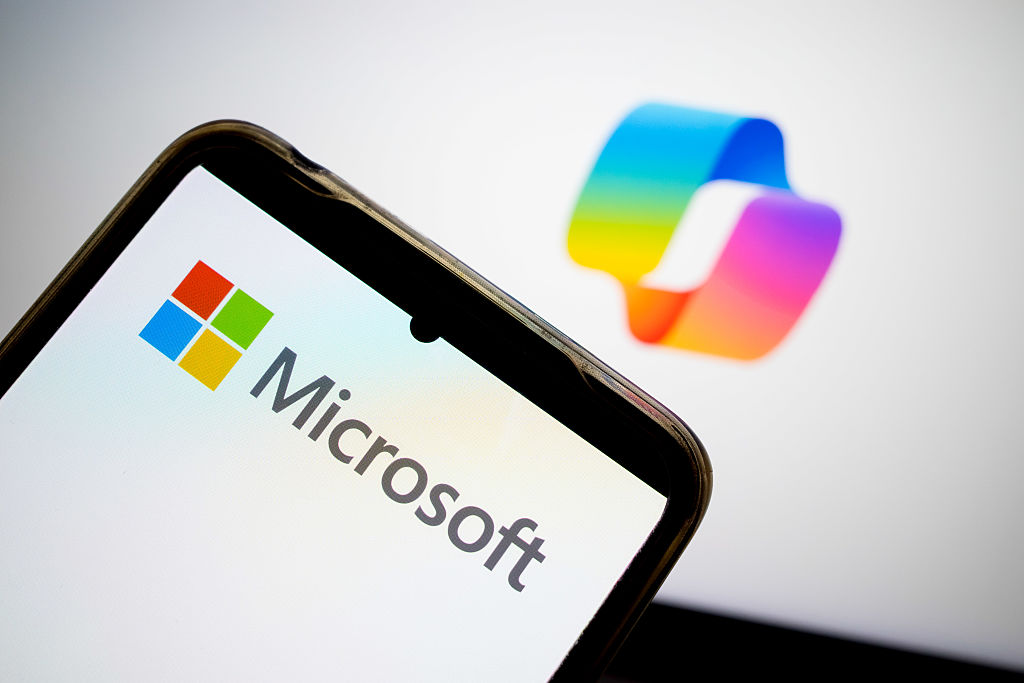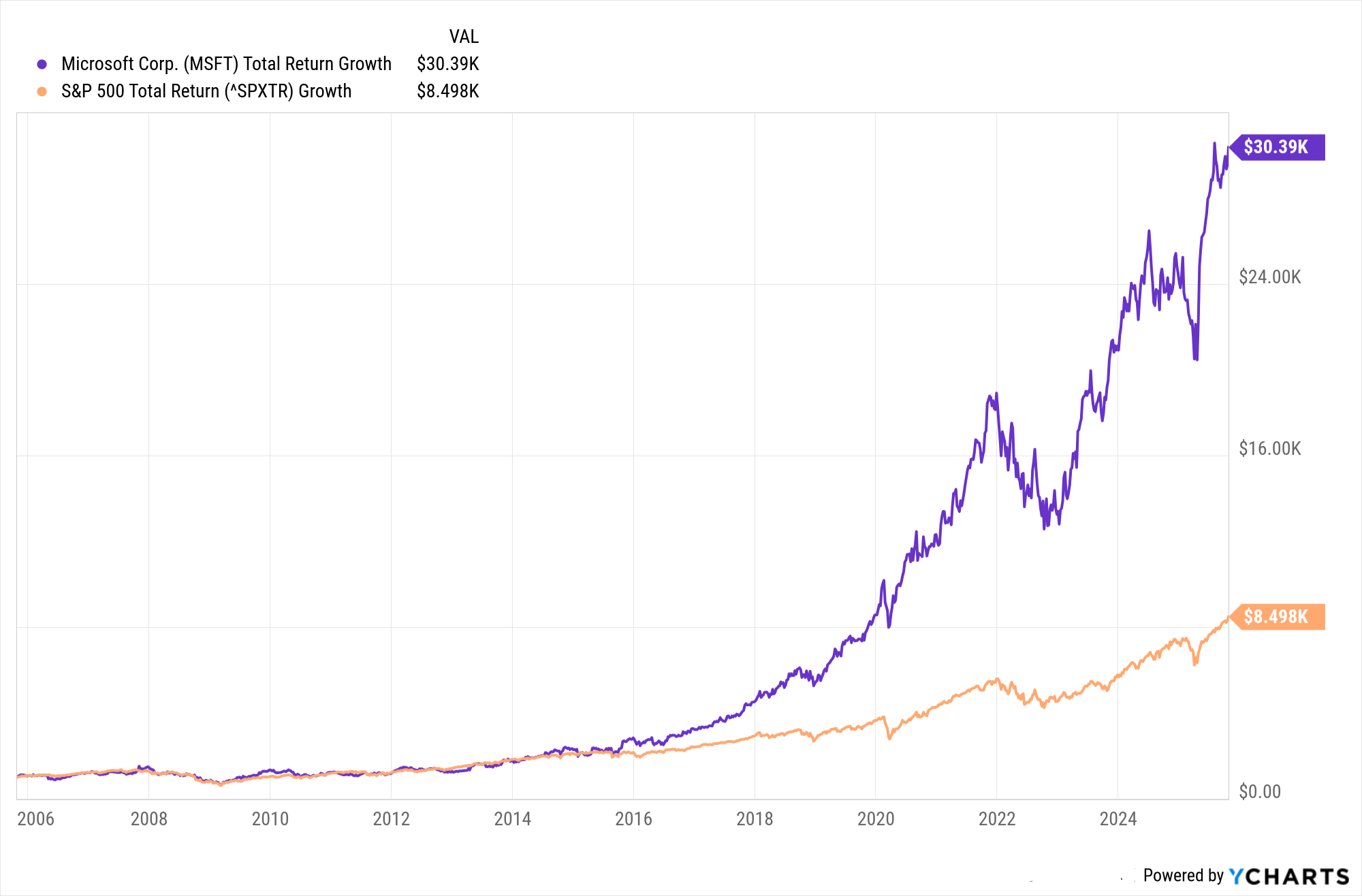If You'd Put $1,000 Into Microsoft Stock 20 Years Ago, Here's What You'd Have Today
Microsoft has been an astounding buy-and-hold bet for truly long-term investors.



Not too long ago, Microsoft (MSFT) stock's glory days looked to be behind it as sales of desktop PCs slipped into a seemingly irreversible decline.
Although the dot-com days of the 1990s minted many a "Microsoft millionaire," the aftermath of the tech bust led Microsoft stock to trade mostly sideways for more than a decade.
But the past 10-plus years have been nothing short of a renaissance for the tech giant. When CEO Satya Nadella ascended to the top job in 2014, he not only began instituting cultural changes, but he transformed Microsoft's core strategy too.
From just $107.88 $24.99 for Kiplinger Personal Finance
Become a smarter, better informed investor. Subscribe from just $107.88 $24.99, plus get up to 4 Special Issues

Sign up for Kiplinger’s Free Newsletters
Profit and prosper with the best of expert advice on investing, taxes, retirement, personal finance and more - straight to your e-mail.
Profit and prosper with the best of expert advice - straight to your e-mail.
Cloud computing and subscription-based services were in; the days of selling software licenses via physical compact disks were passé.
That focus on enterprise customers and – most importantly – Microsoft's shift to selling cloud-based services such as Azure and Office 365 has been an astounding success.
Today, Microsoft is a dominant player in cloud computing and a leader in artificial intelligence (AI) – and MSFT's returns prove it.
Indeed, Microsoft stock has been so remunerative since Nadella took over that long-term investors might not even notice that dud decade-plus following the tech bust.
Between January 1990 and December 2020, shares in Microsoft, which joined the Dow in 1999 at the height of the dot-com boom, generated a total return of 57,730%. The S&P 500's total return came to a mere 1,950% over the same span.
Along the way, Microsoft generated $1.91 trillion in wealth for shareholders, good for an annualized dollar-weighted return of 19.2%, according to Hendrik Bessembinder, professor of finance at the W.P. Carey School of Business at Arizona State University.
Only Apple (AAPL) generated more wealth for shareholders over those three decades, making Microsoft one of the best stocks of the past 30 years, per Bessembinder's findings, which account for cash flows in and out of the business and other adjustments.
The bottom line on Microsoft stock
Have a look at the chart below and you'll see that if you put a grand into Microsoft stock two decades ago, it would be worth more than $30,000 today. That's good for an annualized total return (price change plus dividends) of 18.7%.
The same amount invested in the S&P 500 20 years ago would theoretically be worth about $8,500 today, or 11.4% annualized.

But wait, there's more.
Over its entire life as a publicly traded company, Microsoft has generated an annualized total return of 22.3%. The S&P 500's total return comes to 10.8% annualized over the same span.
Happily for Microsoft bulls, analysts very much expect shares to continue their market-smashing ways.
Of the 58 analysts issuing opinions on Microsoft stock surveyed by S&P Global Market Intelligence, 45 call it a Strong Buy and 13 say Buy.
It's rare for a stock with this much coverage to receive no Hold or Sell calls. The result is a consensus recommendation of Strong Buy with extremely high conviction.
No wonder MSFT routinely ranks as a top-rated Dow Jones stock, as well as one of analysts' top S&P 500 stocks to buy now.
Check out the stocks billionaires are buying or hedge funds' top blue chip stocks and you'll see that much of the putative smart money agrees with Wall Street's assessment.
More Stocks of the Past 20 Years
- If You'd Put $1,000 Into Netflix Stock 20 Years Ago, Here's What You'd Have Today
- If You'd Put $1,000 Into Nvidia Stock 20 Years Ago, Here's What You'd Have Today
- If You'd Put $1,000 Into Amazon Stock 20 Years Ago, Here's What You'd Have Today
Profit and prosper with the best of Kiplinger's advice on investing, taxes, retirement, personal finance and much more. Delivered daily. Enter your email in the box and click Sign Me Up.

Dan Burrows is Kiplinger's senior investing writer, having joined the publication full time in 2016.
A long-time financial journalist, Dan is a veteran of MarketWatch, CBS MoneyWatch, SmartMoney, InvestorPlace, DailyFinance and other tier 1 national publications. He has written for The Wall Street Journal, Bloomberg and Consumer Reports and his stories have appeared in the New York Daily News, the San Jose Mercury News and Investor's Business Daily, among many other outlets. As a senior writer at AOL's DailyFinance, Dan reported market news from the floor of the New York Stock Exchange.
Once upon a time – before his days as a financial reporter and assistant financial editor at legendary fashion trade paper Women's Wear Daily – Dan worked for Spy magazine, scribbled away at Time Inc. and contributed to Maxim magazine back when lad mags were a thing. He's also written for Esquire magazine's Dubious Achievements Awards.
In his current role at Kiplinger, Dan writes about markets and macroeconomics.
Dan holds a bachelor's degree from Oberlin College and a master's degree from Columbia University.
Disclosure: Dan does not trade individual stocks or securities. He is eternally long the U.S equity market, primarily through tax-advantaged accounts.
-
 4 Great Tools to DIY Your Own Financial Plan
4 Great Tools to DIY Your Own Financial PlanSmart Savings Several tools picked out by Kiplinger that DIYers can use to make their own financial plan.
-
 The 7-Month Deadline That Sets Your Lifetime Medicare Premiums
The 7-Month Deadline That Sets Your Lifetime Medicare PremiumsUnderstanding Medicare enrollment is crucial, as missing deadlines can lead to permanent late enrollment penalties and gaps in coverage.
-
 Retirees Living in Portugal: You Need a Post-NHR Tax Strategy
Retirees Living in Portugal: You Need a Post-NHR Tax StrategyWhen your 10-year Non-Habitual Resident tax break ends, you could see your tax rate soar. Take steps to plan for this change well before the NHR window closes.
-
 If You're a U.S. Retiree Living in Portugal, Your Tax Plan Needs a Post-NHR Strategy ASAP
If You're a U.S. Retiree Living in Portugal, Your Tax Plan Needs a Post-NHR Strategy ASAPWhen your 10-year Non-Habitual Resident tax break ends, you could see your tax rate soar. Take steps to plan for this change well before the NHR window closes.
-
 Stocks Chop as the Unemployment Rate Jumps: Stock Market Today
Stocks Chop as the Unemployment Rate Jumps: Stock Market TodayNovember job growth was stronger than expected, but sharp losses in October and a rising unemployment rate are worrying market participants.
-
 The Delayed November Jobs Report Is Out. Here's What It Means for the Fed and Rate Cuts
The Delayed November Jobs Report Is Out. Here's What It Means for the Fed and Rate CutsThe November jobs report came in higher than expected, although it still shows plenty of signs of weakness in the labor market.
-
 Your Year-End Tax and Estate Planning Review Just Got Urgent
Your Year-End Tax and Estate Planning Review Just Got UrgentChanging tax rules and falling interest rates mean financial planning is more important than ever as 2025 ends. There's still time to make these five key moves.
-
 What Makes This Business So Successful? We Find Out From the Founder's Kids
What Makes This Business So Successful? We Find Out From the Founder's KidsThe children of Morgan Clayton share how their father's wisdom, life experience and caring nature have turned their family business into a respected powerhouse.
-
 Stocks Struggle Ahead of November Jobs Report: Stock Market Today
Stocks Struggle Ahead of November Jobs Report: Stock Market TodayOracle and Broadcom continued to fall, while market participants looked ahead to Tuesday's jobs report.
-
 Past Performance Is Not Indicative of Your Financial Adviser's Expertise
Past Performance Is Not Indicative of Your Financial Adviser's ExpertiseMany people find a financial adviser by searching online or asking for referrals from friends or family. This can actually end up costing you big-time.
-
 I'm a Financial Planner: If You're Not Doing Roth Conversions, You Need to Read This
I'm a Financial Planner: If You're Not Doing Roth Conversions, You Need to Read ThisRoth conversions and other Roth strategies can be complex, but don't dismiss these tax planning tools outright. They could really work for you and your heirs.